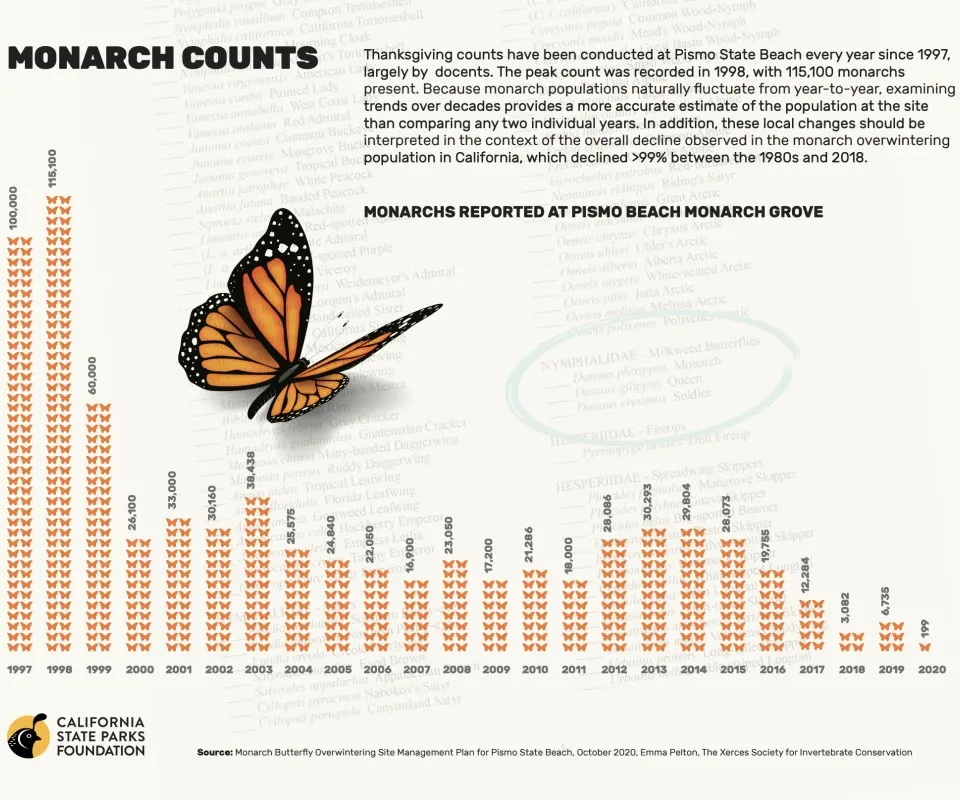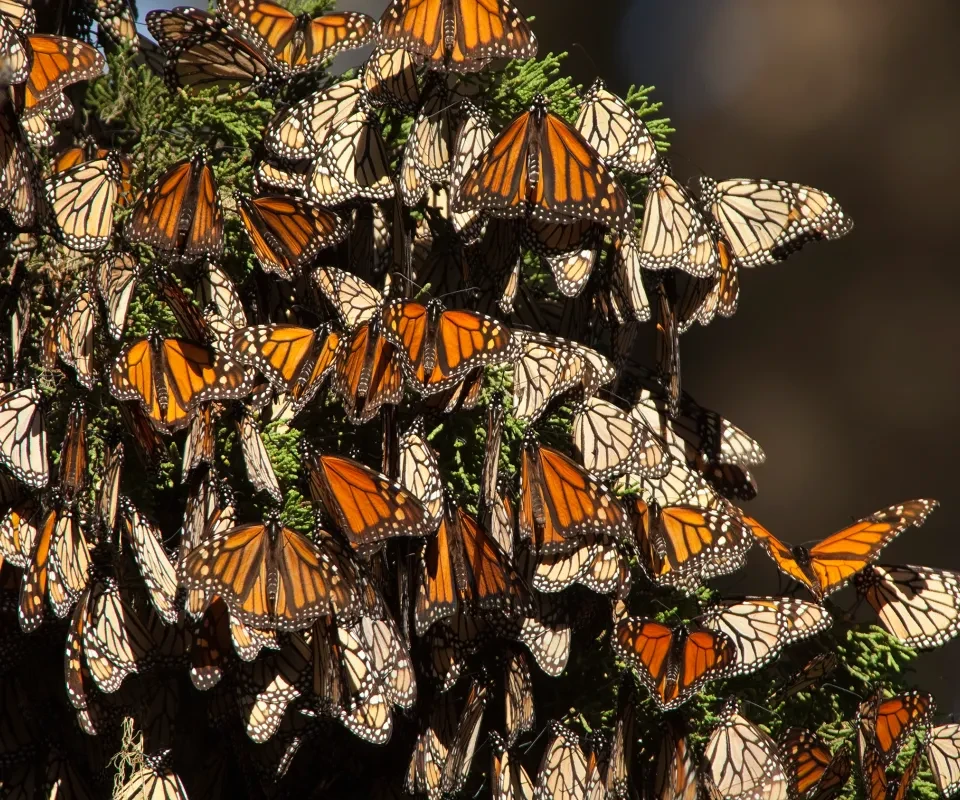The western monarch is arguably one of the most recognizable butterflies in California.
Hundreds of thousands of monarch butterflies (Danaus plexippus) rely on the forested groves of the Pacific coast stretching from Mendocino County, California to Baja to overwinter. In the 1980s, an estimated 4.5 million butterflies migrated to the coast annually. However, by the mid-2010s, the population declined to 200-300 thousand butterflies. And in both 2018 and 2019, volunteers counted under 30,000 monarchs — less than 1% of the population’s historic size. In 2020, volunteers counted less than 2,000 monarchs — that’s less than 0.01% of the historic size.
Migration
Western monarchs living west of the Rockies migrate to the coast of central and southern California. After mating, female monarchs lay their eggs on milkweed plants. Several generations of adult butterflies are produced throughout the spring, summer, and fall. Each fall, the last generation of monarch butterflies migrates to overwintering habitat. As colder weather approaches, the butterflies instinctively know they must fly south to escape the freezing temperatures. Some have to fly over 1,000 miles. Researchers are still investigating what directional aids monarchs use to find their overwintering location. It is thought to be a combination of directional aids such as the magnetic pull of the earth and the position of the sun. By November, most monarchs are sheltering in trees across California – and many are in California state parks!
The majority of overwintering sites along the Pacific Coast are located within 1.5 miles of the Pacific Ocean or San Francisco Bay. Some overwintering sites in California state parks include:
- Pismo State Beach
- Lighthouse Field State Beach
- Leo Carrillo State Park
- Natural Bridges State Beach
- Morro Bay State Park
- Montaña de Oro State Park
- Point Lobos State Natural Reserve
- Andrew Molera State Park
California state parks provide shelter and protection for this iconic species. State parks are home to key monarch overwintering sites and located along important migration routes, the California state park system holds critical habitat for western monarchs. These places provide the appropriate microclimate conditions for clustering, as well as providing nectar resources and minimizing stressors to the butterflies.
Monarch aggregations will continue through January or into February. The butterflies cluster in dense groups on the branches, leaves, or even the trunks of trees. The adults usually remain in reproductive diapause throughout the winter and activity is limited to occasional sunning, rehydrating, and nectaring. In February and March, the surviving monarchs breed at the overwintering site before dispersing.
Threats
The significant problems afflicting western monarchs are habitat loss (overwintering and breeding areas), pesticide use (herbicides and insecticides), and climate change (including increased drought severity and frequency).
Habitat loss
One of the significant problems afflicting western monarchs, and in particular their life cycle, is habitat loss in their overwintering and breeding areas. Monarchs require specific microhabitat conditions to successfully overwinter, including protection from freezing temperatures and high winds, sufficient humidity, sunlight, fresh water, and nectar sources. Grove microclimate conditions change as forests age and as a result of human activities. The California Department of Parks and Recreation is implementing adaptive management plans to maintain suitable conditions for monarchs. The goal of these plans is to restore, maintain, and improve the sites’ value as habitat for overwintering monarchs.
Pesticide use
Pesticides are commonly used in urban and agricultural environments to kill invertebrate pests, diseases, and weeds. However, many pesticides harm pollinators and other beneficial insects. Their effects include removing important floral resources, causing subtle yet concerning effects on reproduction, navigation, and memory. It is critical that we work simultaneously to reduce use of pesticides and to minimize the risk of pesticides to pollinators where pesticides are used.
Climate change
A number of traits make monarchs vulnerable to a changing climate. Like most butterflies, monarchs are highly sensitive to weather and climate. They depend on environmental cues, mostly temperature, to trigger reproduction, migration, and hibernation. Their dependence on milkweed alone as a host plant is a further vulnerability, particularly as milkweed abundance is declining throughout the monarch range. They also face a decline in their overwinter habitat, with increasing frequency of extreme weather events like drought, severe storms, and extremes in hot and cold temperatures.
In addition, captive breeding monarch butterflies can be dangerous. Captive breeding is the practice of keeping adult monarchs in captivity and creating a colony to produce hundreds or thousands of monarchs. Rearing monarchs in captivity can promote an increase in parasites, which can then be spread to wild monarchs when they are released. Secondly, continuous rearing over multiple generations can dilute genetic diversity, and have adverse effects on wild populations.
Monitoring
Observations of monarch distribution and abundance in a grove are critical to understanding site suitability, the vulnerabilities of a site are expressed by the movements of monarchs themselves. Monitoring should be done as frequently as possible during the overwintering season to capture changing distributions through the season and in response to storm events. Monarch counts are done in the morning, before monarchs become active. During the middle of the day, observations of monarchs sunning and nectaring can be made to identify habitats that are utilized for these activities.
The best way to learn about the monarch overwintering counts is to look through the Western Monarch Count website. Check out the Step by Step Monitoring Guide about becoming a Western Monarch Thanksgiving Count Monitoring volunteer available under the resources section of this website.
Action
Every program, every initiative, and every action we take at California State Parks Foundation follows an intentional through-line. Our work with state parks and monarch butterflies is no different. The through-line: we learn, we educate, we activate, and we influence. This through-line extends and amplifies our in-the-field learnings, model programs, and innovative solutions to ultimately influence policy and funding decisions in Sacramento and address the critical needs of our state park system, for the benefit of all.
California State Parks Foundation, California State Parks, the general public, and many partners are in a position to take action to help monarch butterflies.
LEARN: We are constantly learning about the latest on-site management, threats, solutions and more from some of the best in the field. We are learning from Xerces Society, Groundswell Coastal Ecology, the California Department of Parks and Recreation, U.S. Forest Service, and many other organizations doing work to protect and preserve monarch butterflies. Specifically with the Department of Parks and Recreation, we are reviewing each overwintering site and current project in each park district.
EDUCATE: We are sharing what we learn to help others understand the issues and solutions that impact monarchs. We are informing the public about state parks and monarch conservation, educating people on what they can do to help, and shining a light on the critical status of monarch butterfly.
ACTIVATE: First, we are supporting partners and California state parks through grantmaking for habitat enhancement and protection. Second, we are partnering with the California Department of Parks and Recreation and Groundswell Coastal Ecology on volunteer workdays at Lighthouse Field State Beach and Natural Bridges State Beach. One of our key focuses is removing invasive plants and planting native nectar plants to support migrating and overwintering wild monarch butterflies. Read more about workday information and sign up here.
INFLUENCE: We are monitoring current federal legislation to protect monarchs: Monarch and Pollinator Highways Act of 2021 and Monarch Action, Recovery, and Conservation of Habitat Act of 2021. The Monarch and Pollinator Highways Act of 2021 would work with local tribes and farmers to expand highway and agricultural buffers to promote early and late flowering nectar plants to support pollinators in general and specifically help migrating monarch butterflies as they approach and move between nearby critical overwinter sites. The Monarch Action, Recovery, and Conservation of Habitat Act of 2021 will provide funding for conservation activities to restore, enhance, and manage overwintering and breeding habitats of monarch populations in the western U.S.
Sources:
- California State Parks, https://www.parks.ca.gov/?page_id=23795
- Xerces Society, https://xerces.org/publications/fact-sheets/western-monarch-call-to-action
- Forest Service, United States Department of Agriculture, https://www.fs.fed.us/wildflowers/pollinators/Monarch_Butterfly/migration/
- Groundswell Coastal Ecology, https://groundswellecology.org/building-pollinator-cooridors/

